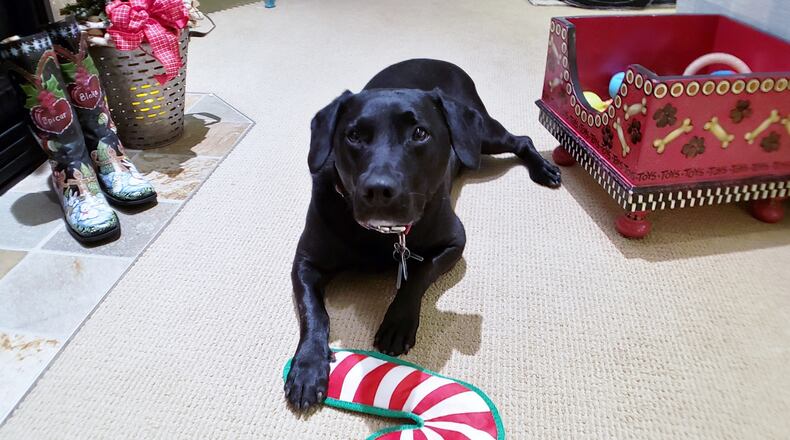So, we were surprised when Teddy emerged from the kitchen with red and white specks on his back, bottom, paws and legs. Only one item in the kitchen fit the description: the box of candy canes.
And sure enough, as we rounded the bar and headed into the kitchen, we saw the pantry door wide open, the candy cane box crushed on the floor, most of the candy canes broken. Maybe a Christmas poem?
I quickly did a web search on dogs and candy canes. The information I found wasn’t good.
First, according to rover.com, sugar-free candy canes sometimes contain Xylitol, an alternative sweetener that can be deadly if dogs consume it. Fortunately, our candy canes weren’t sugar-free.
As I scrolled down the article, my relief was short-lived. Besides Xylitol, dog parents should also look out for the candy cane wrappers and the candy’s sharp edges.
The plastic wrappers that surround the candy as well as the box they come in can cause problems if digested. If the plastic doesn’t pass through their system, blockages in dogs’ intestines and/or sticking to their stomach lining could result.
According to doghint.com, as a dog munches on a candy cane it splits into smaller, sharp-edged pieces like chicken bones. These could injure a dog’s gums, intestines or stomach lining.
Armed with that information, my husband, Ed, and I took a good look at the box. Most of the candy canes were broken but still in their slots. Looking at Teddy more closely, the bits and pieces of candy cane were concentrated on his bottom and back paws.
“That’s odd,” I brilliantly surmised. “It looks like Teddy was sitting on the box, not eating the candy canes.”
“Looks that way to me,” Ed laughed. “And this is what he was going after.” Ed held up a chewed bag of Teddy’s dental chew treats.
The bag had a big hole in the side where the pooch had ripped apart and pulled out several of the treats. Treats, by the way, that are the dog’s favorites.
“So how many did you eat, my boy?” Ed asked the black Lab.
Teddy walked away, tail joyously wagging and teeth sparkling bright.
So, this year’s Christmas poem started the way the event happened, but I used the time-worn “literary license” and changed the ending. Eating a bunch of doggy dental chews didn’t have quite the punchy holiday ending as candy canes.
Grab a candy cane or, if you prefer, a doggy dental treat and enjoy.
It was Christmas Eve but Teddy wasn’t grr-rr-rr-ing!
In fact, and instead, like our Pip, he was purring.
His fur’s red-and-white specks matched those on the floor,
So we followed the specks to our pantry’s door,
And once opened wide, all of us eyed¼
Candy cane pieces and handles in piles,
each doggy-sampled.
Hence Teddy’s wide smiles!
No matter the moment. No matter the flavor.
Here’s wishes to all for a Christmas to savor!
Holiday treats for dogs
1. Carrots
2. Peanut butter
3. Eggs
4. Pineapple
5. Apples
SOURCE: Healthline.com/nutrition/human-foods-for-dogs
About the Author

